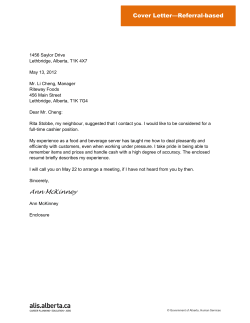
Nitrogen-Doped Graphene-Oxide Quantum Dots as Photocatalysts
Research Express@NCKU - Articles Digest Research Express@NCKU Volume 29 Issue 1 - April 24, 2015 [ http://research.ncku.edu.tw/re/articles/e/20150424/1.html ] Nitrogen-Doped Graphene-Oxide Quantum Dots as Photocatalysts for Overall Water-Splitting under Visible Light Illumination Te-Fu Yeh1, Chiao-Yi Teng1, Shean-Jen Chen2,3, Hsisheng Teng1,2,* 1 Department of Chemical Engineering, National Cheng Kung University 2 Center for Micro/Nano Science and Technology, National Cheng Kung University 3 Department of Engineering Science, National Cheng Kung University hteng@mail.ncku.edu.tw Advanced Materials, DOI: 10.1002/adma.201305299 (2014) W e have recently succeeded in producing nitrogen-doped graphene oxide quantum dots (NGO-QDs) with large surface area and optimized functionalization. Visible-light illumination of NGO-QDs in pure water resulted in evolution of H2 and O2 at a molar ratio of approximately 2:1. We hypothesize that the unique character of the NGO-QDs are caused by p- and n-domains in the material. The sp2 clusters in NGO-QDs can serve as the junction between the p- and n-domains and are the recombination sites for majority carriers from the two domains (Scheme 1). This photochemical diode-type mechanism for water splitting over NGO-QDs shows interesting analogies to that of biological photosynthesis and could provide a strategy to design semiconductor architectures on graphene to mimic the vectorial charge displacement in biological photosynthesis. The preliminary findings highlight the potential of NGO-QDs for water splitting achievable in a sustainable and environmentally-friendly manner. However, optimization of the material is required to compete with traditional photocatalysts in terms of yield and long term stability. We are still on the way to increase our fundamental understanding of the materials and design strategies for improving the efficiency. Scheme 1 (Left) structure of nitrogen-doped graphene oxide quantum dots, NGO-QDs. (Right) p-n diode configuration of NGO-QDs for water splitting. 1 of 2 Research Express@NCKU - Articles Digest 2 of 2 Research Express@NCKU - Articles Digest Research Express@NCKU Volume 29 Issue 1 - April 24, 2015 [ http://research.ncku.edu.tw/re/articles/e/20150424/2.html ] In vivo anti-cancer efficacy of magnetite nanocrystal based system using locoregional hyperthermia combined with 5-fluorouracil chemotherapy Tsung-Ju Lia, Chih-Chia Huangb,c,e, Pin-Wei Ruanb, Kuei-Yi Chuangb, Kuang-Jing Huangd, DarBin Shieha,d,e,* , Chen-Sheng Yehb,e a Institute of Basic Medical Sciences, National Cheng Kung University, Tainan 70101, Taiwan b Department of Chemistry, National Cheng Kung University, Tainan 701, Taiwan c Biophotonics and Molecular Imaging Research Center (BMIRC), National Yang-Ming University, Taipei 112, Taiwan d Institute of Oral Medicine, National Cheng Kung University Hospital, College of Medicine, National Cheng Kung University, Tainan 701, Taiwan e Advanced Optoelectronic Technology Center and Center for Micro/Nano Science and Technology, National Cheng Kung University, Tainan 701, Taiwan dshieh@mail.ncku.edu.tw Biomaterials Volume 34, Issue 32, Pages 7873–7883 (2013) Hyperthermia (or thermotherapy) is one alternative cancer therapy available for advanced disease states. Experimental results showed that by exposing tumor to temperature around 41-45C for a period of time can damage or kill cancer cells while only minimally injure normal tissue (Hartman 2008). Cancer lesions present intrinsic acidity and low oxygen environment which provide resistance to chemotherapy and radiation. These factors also render cancer cells more sensitive to heat.1 Nanoparticles were known to display unique chemical and physical properties once the bulk states. Moreover, the size of nanoparticle can readily penetrate into tissue or even subcellular space. Nanoparticles tailored for many biomedical application such as contrast enhancement in MRI, optical imaging, ultrasonography and other modalities have been developed or on market in the past decades. Currently, clinical obstacle for hyperthermia treatment is due to inefficient delivery of enough heat to deep-seated tumor. Application using superparamagnetic iron oxide nanoparticles for magnetic hyperthermia is believed to be one promising treatment for cancers. Under the exposure of magnetic field, the individual superparamagnetic nanoparticle with single magnet dipole dissipate heat due to main dipole relaxation.2 Although a number of magnetic hyperthermia has been performed by research groups, reports up to date have either described in situ injection of large dosage of iron oxide nanoparticles or long-term exposure of radio-frequency. 3 We developed octahedron iron oxide nanoparticle is capable of targeting Her-2 and can be thermal-triggered to release drug under radiofrequency exposure. Upon radiofrequency exposure, our iron oxide nanoparticles present much higher temperature raise than the commercially available Resovist under 1.3MHz frequency (Fig 1.) 1 of 4 Research Express@NCKU - Articles Digest Figure 1. Fe3O4 nanocrystal has better temperature rise in comparison with commercial Resovist4 After successful modification of the Fe3O4@anti-HER2 nanoparticles to carry 5-FU drugs, intravenous injection was done to the tumor bearing SCID mice. The synchronized locoregional hyperthermia combined with chemotherapy by radiofrequency trigger was done 24 hour post injection. We observed that accumulation of iron oxide to tumor tissue was greatly increased after RF exposure (Fig 2, Left image). Additionally, under thermal camera image we observed hyperthermia induced in solid tumor mass was evident (Fig 2, Right image). Figure 2. Iron stain analysis of the tumor mass after radiofrequency treatment (left) and the thermo image during the treatment (right4). 2 of 4 Research Express@NCKU - Articles Digest We observed that after intravenous injection of anti-Her2 conjugated 5-FU tathered magnetite nanoparticles and radiofrequency exposure, the tumor size on mice significantly regressed as compared to the control groups (Figure 3). This is the first report to prove the concept that locoregional hyperthermia combined with 5-fluorouracil chemotherapy can improve cancer therapy and potentially lower down side effects. This article was published in Biomaterial 2013. Figure 3. Animal study showed that when synchronized hyperthermia with chemotherapy can enhance tumor regression. Reference 1. Moyer, H. R. and K. A. Delman (2008). "The role of hyperthermia in optimizing tumor response to regional therapy." Int J Hyperthermia 24(3): 251-261. 2. Hartman, K. B. W., Lon J.1; Rosenblum, Michael G.2 (2008). "Detecting and Treating Cancer with Nanotechnology." Molecular Diagnosis &Therapy 12: 1-14. 3. Rachakatla, R. S., S. Balivada, et al. (2010). "Attenuation of mouse melanoma by A/C magnetic field after delivery of bi-magnetic nanoparticles by neural progenitor cells." ACS Nano 4(12): 7093-7104. 4. Li, TS., Huang CC., Ruan PW., Chuang KY., Huang KJ., Shieh DB., Yeh CS. (2013). “In vivo anti-cancer efficacy of magnetite nanocrystal - based system using locoregional hyperthermia combined with 5fluorouracil chemotherapy.” Biomaterials 34, 7873–7883. 3 of 4 Research Express@NCKU - Articles Digest 4 of 4 Research Express@NCKU - Articles Digest Research Express@NCKU Volume 29 Issue 1 - April 24, 2015 [ http://research.ncku.edu.tw/re/articles/e/20150424/3.html ] Ionospheric Disturbance Waves Generated by Rockets C. H. Lin1,2,*, J. T. Lin1, C. H. Chen1, J. Y. Liu3,4, Y. Y. Sun3,5, Y. Kakinami6, M. Matsumura7, W. H. Chen1, H. Liu8, R. J. Rau1 1 Department of Earth Sciences, National Cheng Kung University, Tainan, Taiwan 2 Earth Dynamic System Research Center, National Cheng Kung University, Tainan, Taiwan 3 Institute of Space Science, National Central University, Chung-Li, Taoyuan, Taiwan 4 National Space Organization, Hsinchu, Taiwan 5 CIRES, University of Colorado at Boulder, Boulder, CO, USA 6 School of Systems Engineering, Kochi University of Technology, Kami, Kochi, Japan 7 National Institute of Polar Research, Research Organization of Information and Systems, Tokyo, Japan 8 Department of Earth and Planetary Science, Faculty of Science, Kyushu University, Fukuoka, Kyushu, Japan Ann. Geophys., 32, 1145-1152, 2014 doi:10.5194/angeo-32-1145-2014 S imilar to the bow and stern waves generated in the fluid (water surface for example) due to transition of an object, the upper atmospheric neutral density and ionospheric plasma could be disturbed by the rocket fly-by. Using the dense ground-based GPS receiver network around East Asia, we observed disturbance wave signatures in the total electron contents (TECs) measured along the signal ray paths between the receivers and GPS satellites. The V-shape shock wave signatures in GPS-TEC are seen for both 2009 North Korea (eastward trajectory) and 2013 South Korea (southward trajectory) rockets (Fig. 1). Figure 1. Time evolutions of GPS-TEC for (a-f)2009年North Korea and (g-l)2013 South Korea rockets。 Further analysis of GPS-TEC disturbances by calculating the propagation velocities of TEC perturbations along the rectangular boxes in Fig. 1 indicates supersonic wave signatures for the both events (Fig. 2). Extracted TEC disturbance waves of 100-600 sec period show 800-1200 m/s waves propagating perpendicular away from the rocket trajectories. Moreover, the 20-minute delayed disturbance waves are observed in this study for the first time. The delayed waves are likely coming from the disturbances of neutral atmosphere at lower altitude or earlier rocket flight stage. 1 of 2 Research Express@NCKU - Articles Digest Figure 2、Propagating velocities of TEC disturbace waves for (a-b) 2009 North Korea and (c-d) 2013 South Korea rockets. 2 of 2 Research Express@NCKU - Articles Digest Research Express@NCKU Volume 29 Issue 1 - April 24, 2015 [ http://research.ncku.edu.tw/re/articles/e/20150424/4.html ] Multi-Index Hybrid Trie for IP Lookup and Update Chia-Hung Lin1, Chia-Yin Hsu1, Sun-Yuan Hsieh 1,2,3,* 1 Department of Computer Science and Information Engineering, National Cheng Kung University, 2 Institute of Manufacturing Information and Systems, National Cheng Kung University 3 Institute of Medical Informatics, National Cheng Kung University hsiehsy@mail.ncku.edu.tw A multi-index hybrid trie for IP lookup and updates, IEEE Transactions on on Parallel and Distributed Systems, accepted. H igh performance routers require high-speed IP address lookup to achieve wire speed packet forwarding. In this thesis, a new data structure of dynamic router table is proposed for IP lookup and updates, called Multi-Index Hybrid Trie (MIHT). By associating each prefix with a key value, we can perform an IP lookup operation efficiently in a balanced search tree. Furthermore, because the tree height and the number of prefixes that need to be compared is reduced, the dynamic router-table operations can also be performed efficiently. To reduce the memory requirement, for each prefix we store its corresponding suffix in a node of MIHT instead of storing a full binary string. Experiments using real IPv4 routing databases indicate that, the proposed data structure is efficient in memory usage and performs well in terms of lookup, insert and delete operations. We report the results of experiments conducted to compare the proposed data structure with other structures using the benchmark IPv4 prefix databases AS1221, AS4637, AS6447, and AS65000 with 407,067, 219,581, 417,995, and 406,973 prefixes, respectively. 1 of 1
© Copyright 2025










